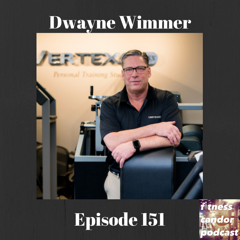Exercise Selection, Order, and Frequency: Dwayne Wimmer on the Fitness Candor Podcast
I was happy to be back on the Fitness Candor podcast with Eric Feigl where we had another great buy soma online discussion about exercise, and what trainees should know about how to create a workout plan that includes a good exercise selection, order, and frequency of workouts. We talked about the components of a solid exercise routine, and how people can keep themselves motivated even when they aren’t with their trainer. You can catch our last conversation about fitness industry best practices as well.
Every once in a while, as trainers we’re asked about the process of setting up an exercise program, whether that’s because they want to understand more about what they’re doing and why, or whether they plan to fly solo for a week or two while on vacation. For the people hoping to get in some exercise while on vacation, I’ll typically take them through a simple dumbbell routine or body exercise routine that mimics what we do in the studio together.
Exercise Selection Should Always Be Safe and Effective
The key, as always, is to be safe and effective, which is why I keep the exercise selection simple with a few squats and push-and-pull exercises for those on vacation. If someone does this only a couple times a week, it’s already a lot more than most people on vacation will do. The simplicity is key to making sure that they don’t have to think too much. It’s never about how much you do, but rather the quality of what you’re doing, which requires a certain level of intensity. It’s always easier to teach someone to work hard on a few simple movements than on really complicated movements. When you have to think too hard about what you’re doing, you will automatically tend to go easier on yourself and not get the effective workout that you need to keep improving.
Your own brain can hijack your workout, especially without the guidance of a trainer: your brain will tell you that you need to stop long before your actual body reaches its physical limits. I don’t tend to start people off with working on the leg press when they first begin a workout routine with me, because it can be a daunting exercise for those who aren’t yet comfortable with working really hard. We need to teach them that it’s okay first, that they won’t get hurt, and that the worst thing that can happen is that they try to move a weight and it doesn’t move. The exercise selection is always important no matter the workout experience of the client.
The Goal of Exercise is Maximum Effort
This is a common sticking point in trainees minds: they think it’s a bad thing if they experience what is known as momentary muscle failure, or we like to call it “Maximum Effort”. They try to move the weight with full effort and good form and they are simply unable to overcome the resistance. In other words, they push on it and it doesn’t move. Many trainees will start to wiggle, hold their breath, or contort in some other way to try to move the weight while abandoning their good form. What they forget is that the movement of the weight is not the goal of the exercise; it is merely the byproduct of their muscles contracting against the resistance. If the weight doesn’t move, and you’re practicing good form and giving full effort, then that’s okay. In fact, that is what we’re looking to have happen.
The exercise selection for my clients’ workouts starts with a few simple compound movements to start. We might spend fifteen or twenty sessions together before they truly begin to feel comfortable with the level of intensity that we’re looking for, and at that point they’re often ready for some more single-joint exercises, like the hip extension. Eric noted that some clients ask why they aren’t doing any bicep or tricep-specific exercises, but the truth is that you can get a great workout on these arm muscles through the work you’re doing on the compound upper-body machines. Once we begin the isolation exercises and they learn those basic skills, the trainee is ready for almost any workout routine, including pre-exhaustion and post-exhaustion routines.
Exercise Selection and Duration
When putting together an exercise routine, many would be surprised at how effective a workout you can get in how little time. For my clients, I normally schedule a full body workout of about 8-12 different exercises to take 25 minutes. Some are convinced that they need to spend hours in the gym every week, but there is a big difference between working for a long time, and working effectively. If you are practicing good form, isolating the targeted muscles, and working at a sufficient intensity, then there is no reason that you can’t continue to experience strength gains on an hour to an hour and a half a week. Doing otherwise can also neglect the important role that rest plays when we exercise, and lead to what we know as overtraining.
The shorter workouts are following the HIT standard of exercise training, which stands for High Intensity Training. The method was pioneered by fitness expert Arthur Jones in the 1970s, who also designed the Nautilus line of exercise equipment designed to more properly isolate the intended muscles during a given exercise. This method doesn’t involve repeated sets of exercise in a circuit, but rather working the intended muscles to momentary failure in about 60 seconds of sustained reps for each exercise.
Learning to reach “positive” failure, or momentary muscular failure, is very challenging for most people to learn to do. Even trainers sometimes find it difficult to find the motivation for exercise. But you learn to push yourself to a point where it doesn’t take long to get done, and you can just put your head down and do the work as you’ve been trained. Don’t forget that you don’t need to be adding weight every week to be making progress–you can be continually improving your form, which will make the same amount of weight more challenging and more effective. You’re not in the gym to lift the weights, your goal in exercise is to make the muscle tired. If you can get more efficient, then you can get stronger even on less weight.
Listen to the Fitness Candor Podcast HERE!
Request a complimentary first session at Vertex Fitness, Voted the BEST Personal Training Studio on the Main Line
Click HERE and we will schedule a session to try it yourself
Complimentary First Workout Session



Leave a Comment